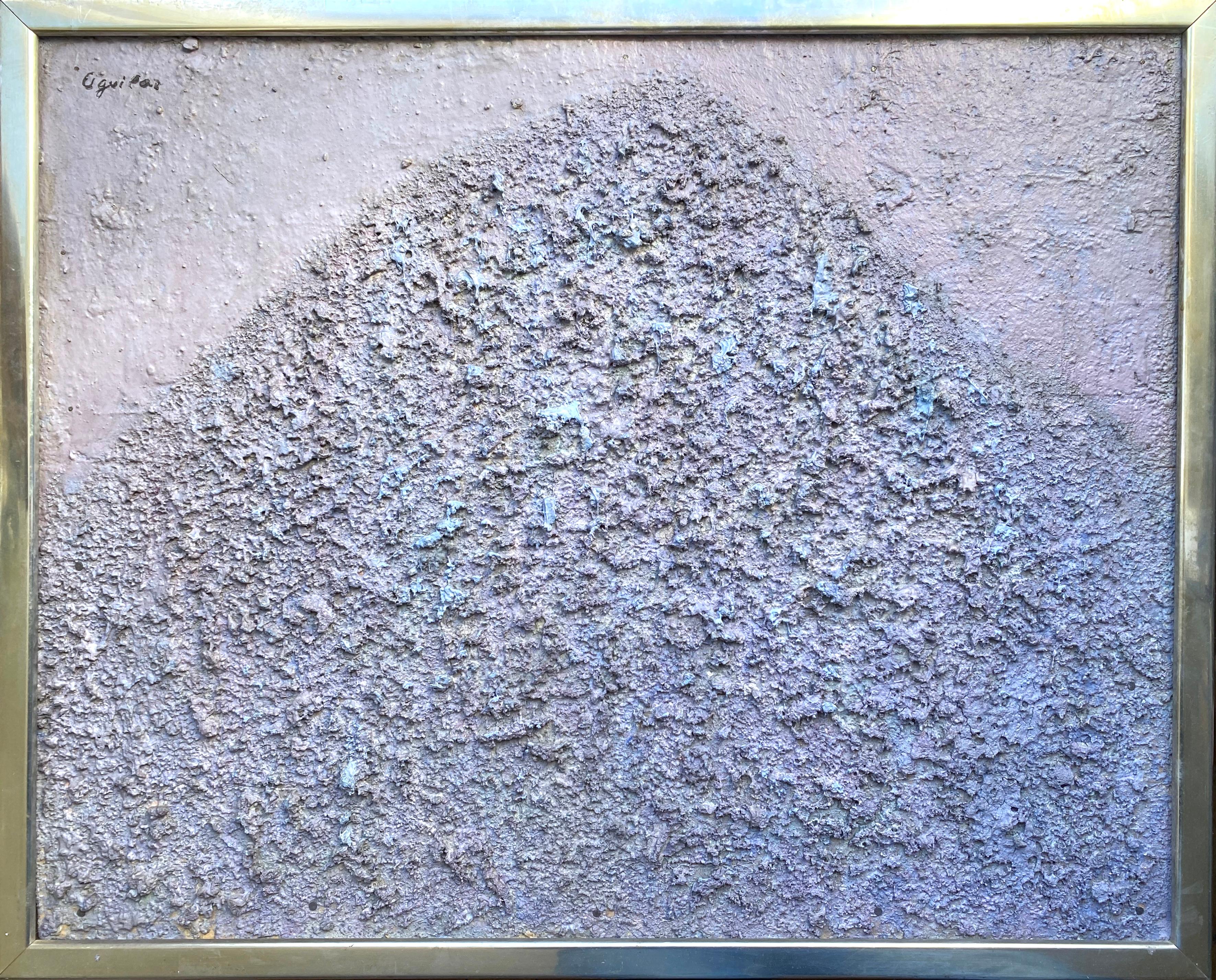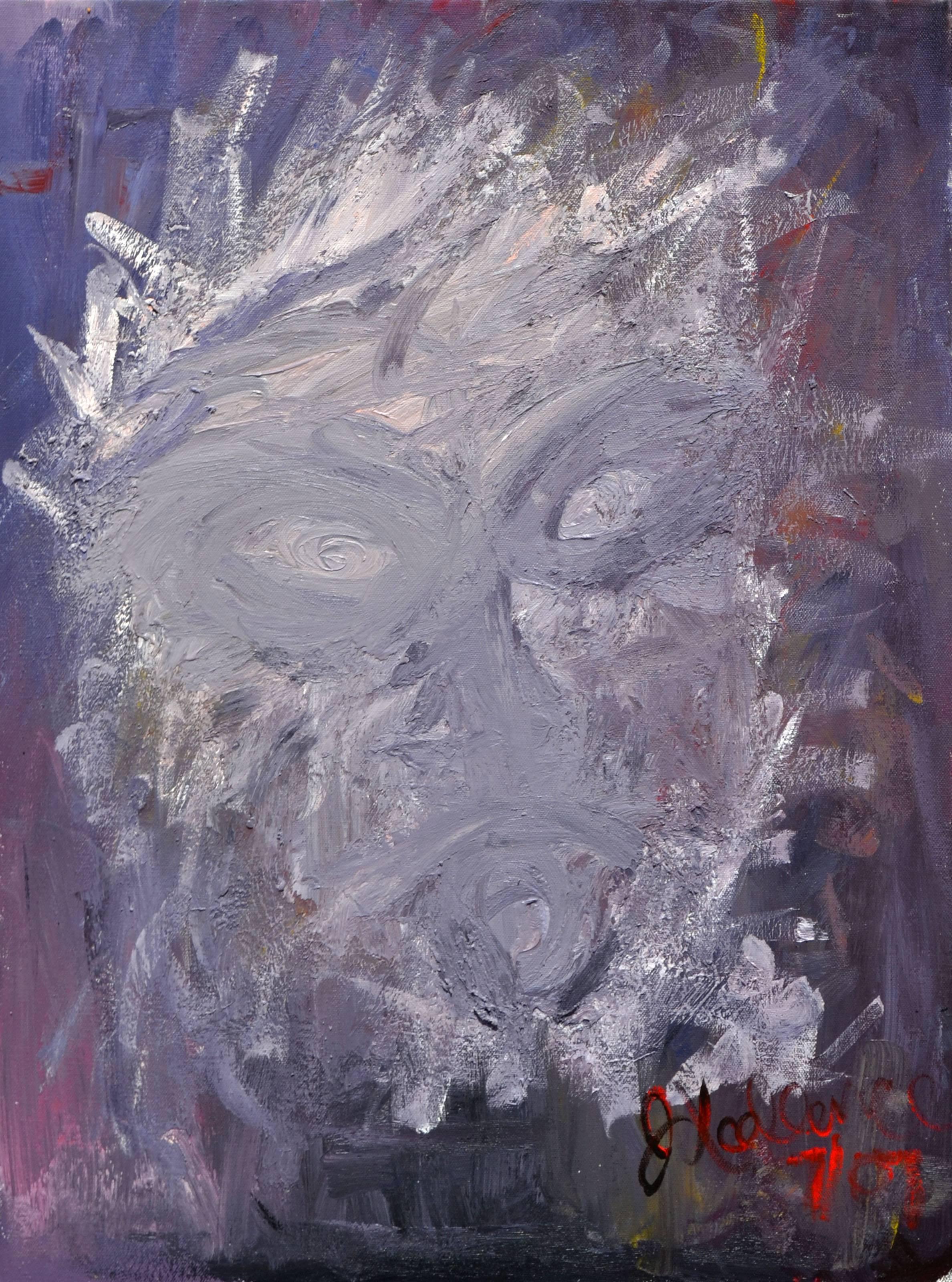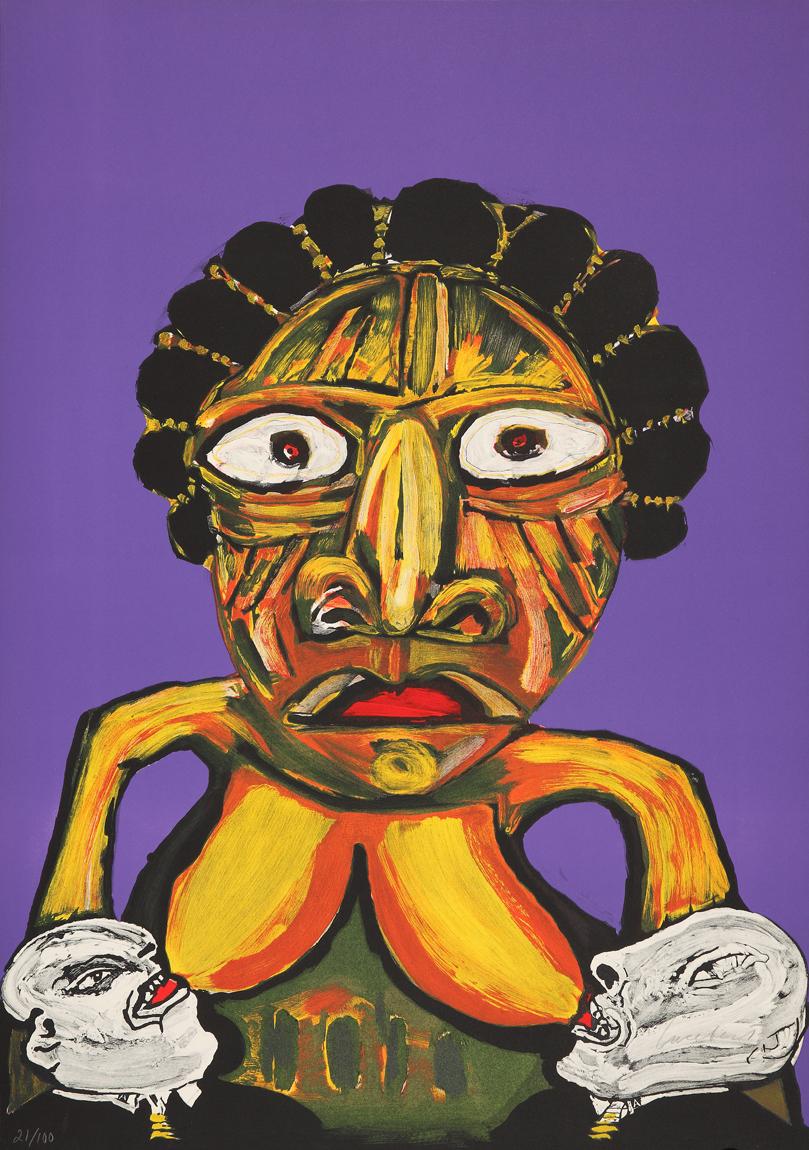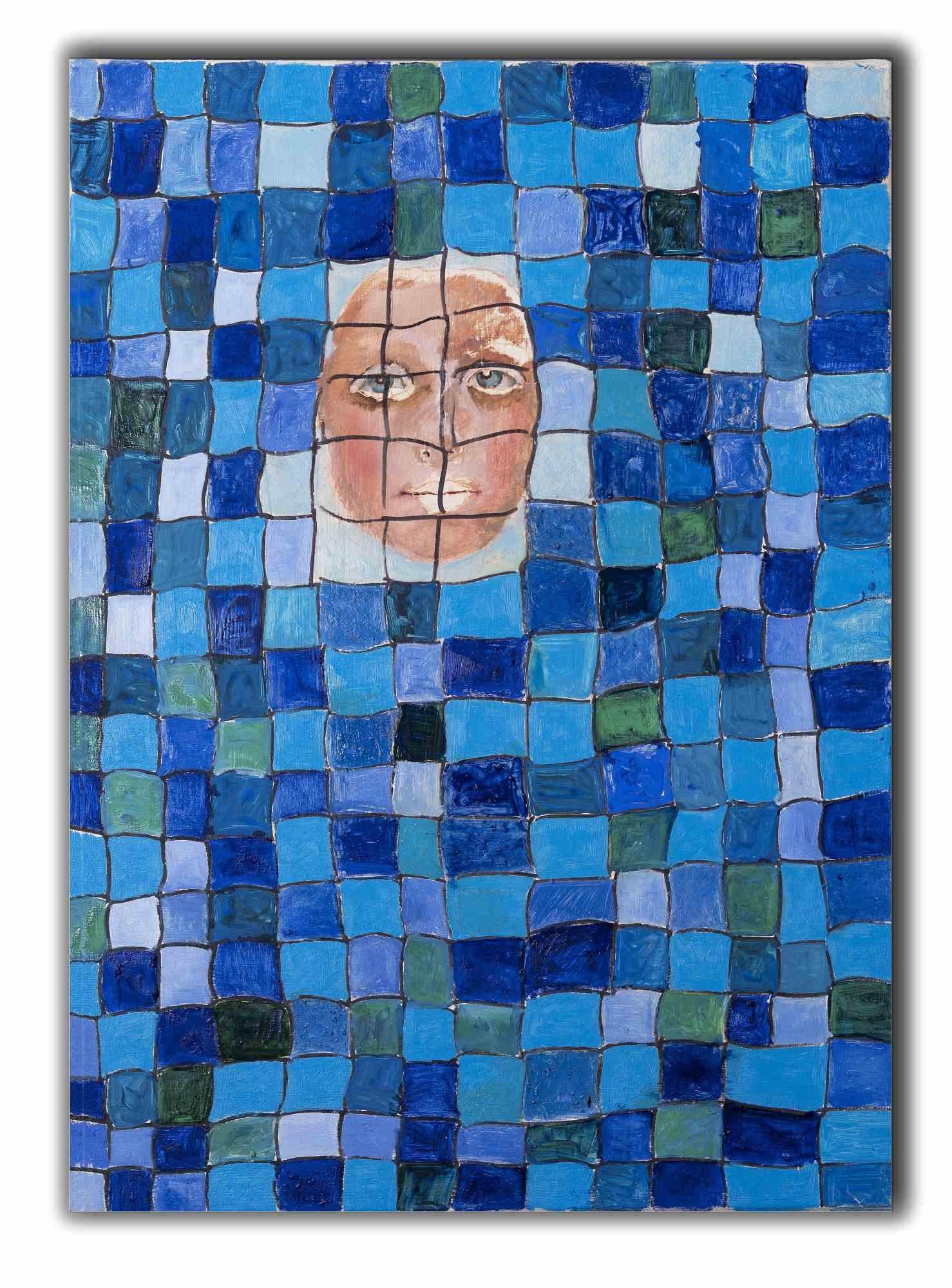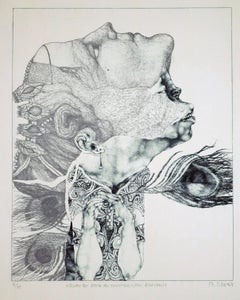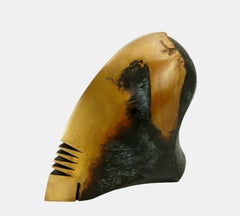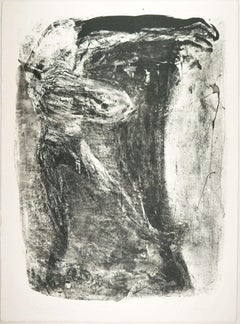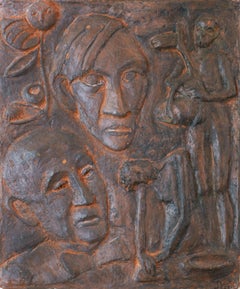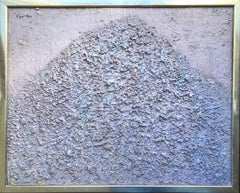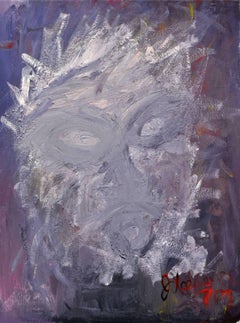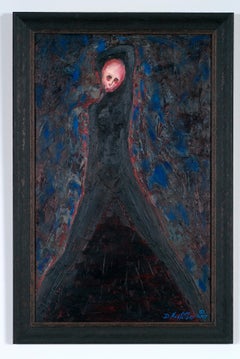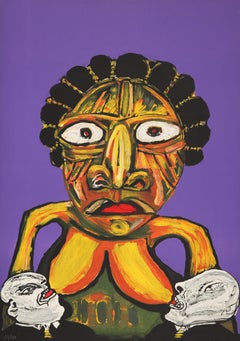Items Similar to White Mask on Violet Ground - Mythic mask mountain -
Want more images or videos?
Request additional images or videos from the seller
1 of 11
Herrmann SchütteWhite Mask on Violet Ground - Mythic mask mountain -1962
1962
$2,758.51
$3,448.1420% Off
£2,054.45
£2,568.0620% Off
€2,320
€2,90020% Off
CA$3,868.95
CA$4,836.1920% Off
A$4,243.21
A$5,304.0120% Off
CHF 2,188.40
CHF 2,735.5020% Off
MX$50,688.75
MX$63,360.9420% Off
NOK 27,755.59
NOK 34,694.4920% Off
SEK 26,037.89
SEK 32,547.3720% Off
DKK 17,678.75
DKK 22,098.4320% Off
About the Item
Hermann Schütte (1893 Osnabrück - 1973 Hamburg), White Mask on Violet Ground. Enameled copper plate on wooden base, 37 x 29.5 cm, monogrammed and dated "S[chütte] [19]62" in the lower right corner of the fire, inscribed on the reverse (by another hand?) with "Hermann Schütte", titled as "Mask" and dated "1962".
- upper corner slightly creased, otherwise very good condition
- Mythic mask mountain -
About the artwork
In his late work, Hermann Schütte discovered the enamel technique for his artistic work, thus establishing a genre between painting and sculpture, which at the same time has something architectural about it through the wall-like structure of the background. But because the 'stone offset' runs vertically, the 'wall' is a 'surreal wall'. It is this fantastic dimension that feeds the mysterious effect of the work. The Prussian blue background is related to the unfathomable depth of Yves Klein's blue. The pronounced craquelé created by the firing also gives the blue an organic vibrancy. It seems to have contracted by itself. The resulting cracks reveal the reddish-brown copper underneath, giving the blue a deep ground on which it seems to 'float'.
Above the moving, vibrant blue ground, which nevertheless appears solid because of the stone-like structure, is a mountain-like formation with two eye slits and a nose, revealing itself - as the title suggests - to be a mask. However, this is not a mask that can be put on, it has a life of its own and is thus in the tradition of medieval leaf masks, the most prominent example of which can be seen on the pedestal of the Bamberg Rider (around 1230).
Shaped like a mountain and equipped with its own nose, the mask also displays its own organic liveliness through the gray surfaces, which are also vertically aligned and seem to have grown, which is further intensified by the sand-like ghostly structure of the white surfaces. The fact that the eye openings remain black and thus blind, yet appear deeper in color than the blue, adds to the mysterious dimension of this enigmatic creature.
The white "mountain mask" and the blue ground create a pattern-ground relationship that is ornamentally enlivened by the craquelure. The vibrant blue ground, reminiscent of Babylonian tiles, and the anthropomorphic mountain mask unfold an archaic, fairy-tale dimension that lends depth to the mysterious and at the same time spreads as a surface sheen.
With the yellow monogramand the year in complementary contrast to the blue, the artist inscribes himself in this mystery.
About the artist
Hermann Schütte grew up in the era of the avant-garde and, like so many artists, volunteered for World War I, only to return home a convinced pacifist after the horrors he had witnessed. Inspired by literary expressionism, he wrote the book "Mensch! God! Ich!". Its cover was illustrated by the spiritus rector of the Worpswede artists' colony, Heinrich Vogeler. After becoming friends with Kurt Schwitters, Schütte created sculptures and installations in the spirit of the Dada movement initiated by Schwitters. During the Nazi era, Schütte withdrew into inner emigration, only to return to intense artistic activity after the Second World War.
Since 1948, Schütte has participated in numerous exhibitions, including those at the Hamburger Kunsthalle, in Oldenburg, Bremen, Worpswede, Witten, Bad Soden, Düsseldorf, and Osnabrück. In 1967, his hometown of Osnabrück dedicated a large monographic exhibition to him, in which 120 of his works provided an overview of his oeuvre.
Selected Bibliography
Rabe, Hanns-Gerd (Einleitung): Hermann Schütte. Ölgemälde, Emailbilder, Federzeichnungen. Katalog zur Ausstellung vom 29. Oktober bis 3. Dezember 1967, Städtisches Museum Osnabrück, Osnabrück 1967.
GERMAN VERSION
Hermann Schütte (1893 Osnabrück - 1973 Hamburg), Weiße Maske auf violettem Grund. Emaillierte Kupferplatten auf Holzgrund, 37 x 29,5 cm, rechts unten im Brand monogrammiert und datiert „S[chütte] [19]62“, rückseitig (von fremder Hand?) mit „Hermann Schütte“ bezeichnet, als „Maske“ betitelt und mit „1962“ datiert.
- obere Ecke leicht bestoßen, sonst in sehr gutem Zustand
Exposé als PDF
- Mystischer Maskenberg -
zum Kunstwerk
In seinem Spätwerk hat Hermann Schütte die Emailtechnik für sein künstlerisches Schaffen entdeckt und damit eine Gattung zwischen Gemälde und Skulptur etabliert, die durch die mauerverbundartige Struktur des Hintergrundes hier zugleich etwas Architektonisches hat. Indem der ‚Steinversatz‘ aber vertikal verläuft, ist die ‚Mauer‘ eine ‚surreale Mauer‘. Aus eben dieser phantastischen Dimension speist sich die geheimnisvolle Wirkung des Kunstwerks. Der in Preußisch Blau gehaltene Hintergrund weist eine Verwandtschaft mit der unergründlichen Tiefe des Blaus von Yves Klein auf. Durch das beim Brand entstandene ausgeprägte Craquelé gewinnt das Blau zudem eine organische Lebendigkeit. Es hat sich scheinbar von sich aus zusammengezogen. Die dabei entstandenen Risse geben das darunterliegende braunrote Kupfer frei, wodurch dem Blau ein Tiefengrund verliehen wird, auf dem es zu ‚schwimmen‘ scheint.
Über dem bewegt lebendigen blauen Grund, der vermittels der steinversatzartigen Struktur dennoch solide erscheint, ist eine bergartige Formation zu sehen, die zwei Augenschlitze und eine Nase aufweist und sich damit – dem Titel entsprechend – als Maske zu erkennen gibt. Diese Maske ist aber keine Maske, die zum Aufsetzen bereitliegen würde, vielmehr führt auch sie ein Eigenleben und steht damit in der Tradition mittelalterlicher Blattmasken, deren prominentesten Beispiel am Postament des Bamberger Reiter (um 1230) zu sehen ist.
Wie ein Berg ausgebildet und mit einer eigenen Nase versehen, weist auch die Maske durch die ebenfalls vertikal ausgerichteten und wie gewachsen wirkenden grauen Flächen eine eigene organische Lebendigkeit auf, die von der sandartig gespengelten Struktur der weißen Flächen noch intensiviert wird. Dass die Augenöffnungen schwarz bleiben und damit blind sind, farblich aber dennoch tiefer als das Blau wirken, befördert die geheimnisvolle Dimension dieses rätselhaften Wesens.
Die weiße ‚Bergmaske‘ und der blaue Grund schließen sich zu einem Muster-Grund-Verhältnis zusammen, das vom Craquelé ornamental belebt wird. Der an babylonische Fliesen gemahnende, lebendige blaue Grund und die anthropomorphe Bergmaske entfalten eine archaisch-märchenhafte Dimension, die dem Geheimnisvollen ihre Tiefe verleiht und sich zugleich als Oberflächenglanz verbreitet.
Mit dem gelben zum Blau in Komplementärkontrast stehenden Monogramm und der Jahreszahl schreibt sich der Künstler selbst in dieses Geheimnis ein.
zum Künstler
Hermann Schütte wuchs in die Zeit der Avantgarden hinein und meldete sich – wie so viele Künstler – freiwillig zum ersten Weltkrieg, um nach den durchlebten Schrecken als überzeugter Pazifist heimzukehren. Vom literarischen Expressionismus erfasst, schrieb er 1919 das Buch "Mensch! Gott! Ich!", dessen Umschlag der Spiritus rector der Künstlerkolonie Worpswede, Heinrich Vogeler, illustrierte. Nachdem Schütte mit Kurt Schwitters in freundschaftlichen Kontakt getreten war, schuf er Plastiken und Installationen im Geiste der von Schwitters initiierten Dada-Bewegung. Während der Zeit des Nationalsozialismus zog sich Schütte in die innere Emigration zurück, um nach dem zweiten Weltkrieg wieder intensiv künstlerisch tätig zu werden.
Seit 1948 nahm Schütte an einer Vielzahl von Ausstellungen teil, u.a. in der Hamburger Kunsthalle, in Oldenburg, Bremen, Worpswede, Witten, Bad Soden, Düsseldorf und Osnabrück. 1967 widmete ihm seine Vaterstadt Osnabrück eine große monographische Ausstellung, auf der 120 seiner Werke eine Übersicht über sein Schaffen vermittelten.
Auswahlbibliographie
Rabe, Hanns-Gerd (Einleitung): Hermann Schütte. Ölgemälde, Emailbilder, Federzeichnungen. Katalog zur Ausstellung vom 29. Oktober bis 3. Dezember 1967, Städtisches Museum Osnabrück, Osnabrück 1967.

About the Seller
5.0
Vetted Professional Seller
Every seller passes strict standards for authenticity and reliability
Established in 2014
1stDibs seller since 2023
21 sales on 1stDibs
- ShippingRetrieving quote...Shipping from: Berlin, Germany
- Return Policy
Authenticity Guarantee
In the unlikely event there’s an issue with an item’s authenticity, contact us within 1 year for a full refund. DetailsMoney-Back Guarantee
If your item is not as described, is damaged in transit, or does not arrive, contact us within 7 days for a full refund. Details24-Hour Cancellation
You have a 24-hour grace period in which to reconsider your purchase, with no questions asked.Vetted Professional Sellers
Our world-class sellers must adhere to strict standards for service and quality, maintaining the integrity of our listings.Price-Match Guarantee
If you find that a seller listed the same item for a lower price elsewhere, we’ll match it.Trusted Global Delivery
Our best-in-class carrier network provides specialized shipping options worldwide, including custom delivery.More From This Seller
View AllUnder the mask of the Venetian girl / - Monstrous Reality -
By Reiner Schwarz
Located in Berlin, DE
Reiner Schwarz (*1940 Hirschberg), Under the mask of the Venetian girl, 1968. Lithograph, 30 cm x 24 (image), 59 cm x 42 cm (sheet size), signed “R.[einer] Schwarz” in pencil lower r...
Category
1960s Surrealist Figurative Prints
Materials
Paper
Helmet Head / - Futuristic Archaism -
Located in Berlin, DE
Karl-Heinz Deutsch (*1940 Karlsruhe), Helmet Head, around 2003. Polished and patinated bronze, 23.5 cm (height) x 25.5 cm (length) x 16 cm (depth), weight 4.9 kg. Monogrammed on the ...
Category
Early 2000s Surrealist Figurative Sculptures
Materials
Bronze
My treasure, my sanctuary / - A Tortured Treasure -
Located in Berlin, DE
Johannes Heisig (*1953 Leipzig), "My treasure, my sanctuary" - To the Christmas Oratorio by Johann Sebastian Bach. Lithograph on strong yellowish laid paper with watermark, 53 x 39.5...
Category
1980s Abstract Expressionist Figurative Prints
Materials
Lithograph
$361 Sale Price
20% Off
Homage à Kahnweiler / - The Appearance of Genius-
Located in Berlin, DE
Irmgard Biernath (1905 Waldheim in Saxony - 1998 Mainz), Hommage à Kahnweiler, 1984. Terracotta relief, burnished red body, 43.5 x 38 cm, mounted on support plate, in wooden frame 57 x 49.5 cm, monogrammed "IB" at lower right.
- Isolated patina losses, but overall good condition, frame slightly bumped.
- The Appearance of Genius-
This homage to Daniel-Henry Kahnweiler shows the gallerist and art theorist as Pablo Picasso portrayed him in his lithographic portrait of 1957.
As an innovative Parisian gallery owner, Kahnweiler had exclusively represented Picasso since 1911, while Picasso had painted his famous portrait of Kahnweiler the previous year as a major work of Cubism. And it is Picasso who appears at the centre of Irmgard Biernath's image. Here, his face echoes the features of the self-portrait he painted in 1907 in the Prague National Gallery.
His eyes are wide open as he gazes into the distance, surrounded by the works of his artistic vision that have already taken shape. On the right is the bronze "Man with Sheep...
Category
1980s Contemporary Figurative Sculptures
Materials
Terracotta
$1,141 Sale Price
20% Off
Threatening to defeat me once and for all / - A Christmas Pietà -
Located in Berlin, DE
Johannes Heisig (*1953 Leipzig), "Threatening to defeat me once and for all" - To the Christmas Oratorio by Johann Sebastian Bach. Lithograph on strong yellowish laid paper with wate...
Category
1980s Abstract Expressionist Figurative Prints
Materials
Lithograph
$361 Sale Price
20% Off
The Hut / - The head of the hat -
By Reiner Schwarz
Located in Berlin, DE
Reiner Schwarz (*1940 Hirschberg), The Hut, 1967. Lithograph, 32.5 cm x 32.5 (depiction), 59 cm x 42 cm (sheet size), signed “R.[einer] Schwarz” in pencil lower right, dated “[19]67”...
Category
1960s Surrealist Figurative Prints
Materials
Paper
You May Also Like
Purple Abstract Mountain:Latin American Modernist Salvadoran sculptural painting
Located in Norwich, GB
A wonderful work by the elusive Salvadoran Mauricio Aguilar which is sculptural as well as pictorial. As I hope the video will show, the artwork offers new perpectives when viewed fr...
Category
1960s Abstract Abstract Paintings
Materials
Wood, Oil, Board
Figure in Purple Abstract
By Daniel David Fuentes
Located in Soquel, CA
Abstract figure in purple by San Jose, California area artist Daniel David Fuentes (AKA, Xavier Lundt) (American, 1978-2016). Bay area abstract expressionist and landscape artist dur...
Category
Early 2000s Abstract Expressionist Abstract Paintings
Materials
Canvas, Oil
David Hostetler, Black, Female, White Face, Dancer, Mask
By David Hostetler
Located in Nantucket, MA
David Hostetler continued to mine dance imagery in his sculpture career. This is a strong, dynamic change in his forms. He is breaking away from crossing the arms in front to this fr...
Category
Early 2000s Contemporary Figurative Paintings
Materials
Oil
Against Apartheid - Africa, Violet, Masque, Figure
Located in Köln, DE
This work by Lucebert from 1983 is part of the portfolio "Against Apartheid". In a very harsh way, he is depicting how white man is fleecing the African continent. In this year, many renowned artists decided to create a portfolio of printmaking works to set a sign against the Apartheid. There was also a touring exhibition. The complete project was supported by the United Nations Special Committee against Apartheid. Please scroll through our seller storefront...
Category
1980s Contemporary Portrait Prints
Materials
Lithograph
Reticulum with mask - Oil On Canvas by Giorgio Lo Fermo - 2020
By Giorgio Lo Fermo
Located in Roma, IT
Reticulum with Mask is an original artwork realized by Giorgio Lo Fermo (b. 1947) in 2020.
Original Oil Painting on Canvas.
Hand-signed, titled and dated on the back of the canvas....
Category
21st Century and Contemporary Abstract Expressionist Abstract Paintings
Materials
Canvas, Oil
MAN MASK
Located in Dallas, TX
Julio Garcia Forte
Cuba
17 3/4 x 13 in
2004
Unframed
Technique: Mixed on Cardboard
Category
21st Century and Contemporary Paintings
Materials
Cardboard
More Ways To Browse
Enamel Copper Plate
Dior Vintage Hat
White Mountains Paintings
Klein Blue
Musterring Vintage
Yves Klein Blue
War Mask
Portrait Pope
Antique Nurses
Hyperrealism Paintings
Painting Antique Windows
Tavern Painting
Tavern Paintings
Moises Vintage
Munich Painting
Pino Art Oil Painting
Pino Oil Painting
All Black Painting
